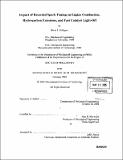| dc.contributor.advisor | John B. Heywood. | en_US |
| dc.contributor.author | Hallgren, Brian E. (Brian Eric), 1976- | en_US |
| dc.contributor.other | Massachusetts Institute of Technology. Dept. of Mechanical Engineering. | en_US |
| dc.date.accessioned | 2006-03-24T18:42:28Z | |
| dc.date.available | 2006-03-24T18:42:28Z | |
| dc.date.copyright | 2005 | en_US |
| dc.date.issued | 2005 | en_US |
| dc.identifier.uri | http://hdl.handle.net/1721.1/30346 | |
| dc.description | Thesis (Ph. D.)--Massachusetts Institute of Technology, Dept. of Mechanical Engineering, 2005. | en_US |
| dc.description | Page 174 blank. | en_US |
| dc.description | Includes bibliographical references (p. 125-126). | en_US |
| dc.description.abstract | An experimental study was performed to determine the effects of substantial spark retard on engine combustion, hydrocarbon (HC) emissions, feed gas enthalpy, and catalyst light-off. Engine experiments were conducted at cold engine conditions for various ignition timings and air/ fuel ratios. Chemical and thermal energy of the exhaust gas was tracked from cylinder-exit to the catalytic converter inlet using a variety of experimental techniques. Time-resolved exhaust port and exhaust runner hydrocarbon concentrations were converted to an exhaust HC mass flow rate and compared to time-averaged downstream HC levels. Quenching experiments quantified cylinder-exit HC emissions by rapidly cooling exhaust gas at the valve seats, effectively freezing HC oxidation reactions. Combustion stability was observed to decrease as the phasing of the 50% mass fraction burned location occurred later in the expansion stroke. A thermodynamic burn rate analysis indicated combustion was complete by exhaust valve opening with spark timings as late as 200 after top-dead-center (ATDC). Engine operation with a relative air/fuel ratio 10% lean of stoichiometric resulted in the lowest observed tailpipe-out HC emissions. Retarded spark timings increased exhaust system oxidation, with port HC oxidation ranging from 15% to 37% with additional HC reductions (40-50%) in the runner for ATDC spark timings. Catalyst light-off times were reduced by 5 seconds and cumulative catalytic converter-in HC emissions were reduced by 44% prior to light-off. A phenomenological model of exhaust system oxidation was developed to provide insight into HC burn-up with late combustion phasing. | en_US |
| dc.description.abstract | (cont.) A detailed chemical kinetic mechanism was coupled with an exhaust flow model and exhaust thermal model. The hydrocarbon tracking and exhaust gas quenching experiments provided initial conditions for a reacting plug flow model. The predicted exhaust HC reaction rates were found to be strongly coupled with exhaust gas temperature and the hydrocarbon species used to represent unburned fuel. The analysis showed that most of the oxidation occurred early in the exhaust period when gas temperatures exceeded 1300K. | en_US |
| dc.description.statementofresponsibility | by Brian E. Hallgren. | en_US |
| dc.format.extent | 174 p. | en_US |
| dc.format.extent | 7923781 bytes | |
| dc.format.extent | 7945439 bytes | |
| dc.format.mimetype | application/pdf | |
| dc.format.mimetype | application/pdf | |
| dc.language.iso | eng | en_US |
| dc.publisher | Massachusetts Institute of Technology | en_US |
| dc.rights | M.I.T. theses are protected by copyright. They may be viewed from this source for any purpose, but reproduction or distribution in any format is prohibited without written permission. See provided URL for inquiries about permission. | en_US |
| dc.rights.uri | http://dspace.mit.edu/handle/1721.1/7582 | |
| dc.subject | Mechanical Engineering. | en_US |
| dc.title | Impact of retarded spark timing on engine combustion, hydrocarbon emissions, and fast catalyst light-off | en_US |
| dc.type | Thesis | en_US |
| dc.description.degree | Ph.D. | en_US |
| dc.contributor.department | Massachusetts Institute of Technology. Department of Mechanical Engineering | |
| dc.identifier.oclc | 61134361 | en_US |

